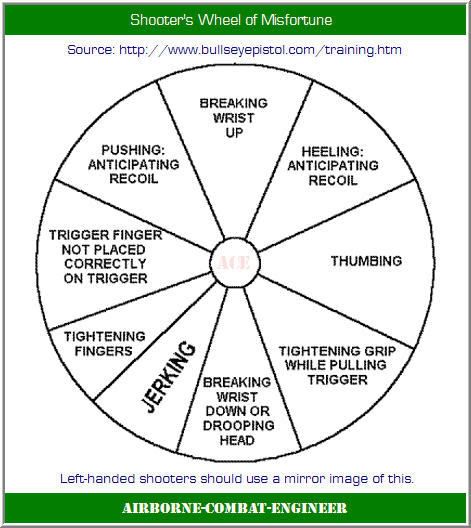Dave2 wrote:So, a "quick" question about this target... What do A, C, E, G, H, and I mean?
Sorry about making you all see angry Cute Puppy. In my defense, he is cute.
A. Some people watch too many movies and see actors shoot a mild, blank 9mm but intentionally follow through way up over their heads...this so that the viewer
really knows they fired the shot. I've seen the same sort of anticipated action at the range with folks thinking the muzzle should be bouncing up 18 inches, so they start that move before they ever break the shot.
Most times, though, the problem here is an unconscious pressing forward, toward the target, before breaking the shot. Think of this as pushing from the bottom of the wrist. You're anticipating a force pressing back against you as the projectile launches, so you press slightly forward.
C. "Thumbing" is the application of too much lateral pressure from the thumb(s). In a modern, two-handed, thumbs-forward grip on a semi-auto, it can happen if the offhand thumb is too low and pressing fully against the frame of the pistol. If there's too much offhand thumb on the frame, and you tighten that grip unconsciously as the shot breaks, it nudges the muzzle toward your strong side.
E. The opposite of A. The same "pushing" effect can occur, but here you are "cowboying," or pushing the muzzle down as you fire. Watch an old black-and-white western, and you'll see some of the actors look like they're trying to throw the bullets out of the barrel, give 'em that little bit of extra
oomph.

This is similar. In anticipation of recoil, you are pushing down and typically a little forward.
I don't think I ever--or at least almost never--see the wrist being relaxed too early, as mentioned on the target. Recoil anticipation is almost always about tightening up, not going loose.
G. Sorta the opposite of "thumbing." This is more likely to happen with a thumb-down single handed grip, or a one-thumb-tucked-under-the-other two-hand grip. If there is less lateral stability on the offhand side of the frame, increasing grip pressure with the strong-hand fingers just before the shot breaks will tend to move the muzzle down and toward the offhand side.
H. Unless you have huge hands or are working with a tiny pistol, this is usually too little trigger finger, not too much. In most cases with a semi-auto, you want the middle of the first pad of the index finger to be on the center of the face of the trigger. The trigger can, mechanically, move only one way: back toward the frame. If the contact point with the trigger is too far toward the tip of the index finger, when pressure is applied the tendency is for the index finger to push against the trigger rather than pulling straight back, in line with the mechanical motion of the trigger. That lateral pressure from the trigger finger will push the muzzle toward the offhand side.
I. This could be interchangeable with B., as far as I'm concerned. It really depends on the pistol you're shooting.
Recoil--despite what we see in movies--is not a straight-line force. The rifling in the barrel imparts a spin to the projectile to stabilize it in flight, and (equal and opposite reactions) the explosive launching of the spinning projectile imparts a rotational element to the recoil. This is felt less in lower-powered guns, guns that have substantial mass, and/or guns that allow a very high grip close to the line of the chamber (like a high-beavertail 1911). Whether the rifling in the barrel is a left-hand or right-hand twist depends on the manufacturer, but that rotational element to the recoil, a torque, will be opposite the direction of the rifling.
If your subconscious knows which way that torque is affecting recoil for your gun, you might tend to anticipate the recoil and start to let the muzzle creep in that direction just before the shot breaks. Frankly, this is a less common trigger control problem than most others, partly because that rotational element to the recoil isn't severe in most common defensive handguns (maybe .357 J-frames aside) if you start out with a high, stable grip and aren't literally scrunching up your face in anticipation of the recoil. Now, if you've decided to get into hunting with a handgun and are going out to the range twice a week with a brand new .454 Casull and slamming a hundred rounds downrange each visit...my bet is that you will definitely begin to anticipate the torque in the recoil.
BTW, targets like this can be very useful, but you have to take the pie-chart segments with a grain of salt. For example, jerking the trigger isn't always gonna put a round into the "F" slice for a right-hander. In the general vicinity, yes; but a trigger jerk could be putting rounds almost anywhere into E, F, or G...even D if he has too much finger on the trigger.
I've also found "diagnostic" targets not terribly helpful for some shooters at certain stages. If the shooter is getting clear, consistent groups, the targets can help eliminate some possibilities and give you some mechanical elements to think about. But if the shooter is peppering the target and not getting definable, five shot groups on a consistent basis, it's time to heed Vince Lombardi's "This is a football" speech and start back with the fundamentals and benchrest work.
I joked about the .454 Casull, but flinch and recoil anticipation is one reason I'm a big believer in dry-fire practice, that it should be the majority of your trigger time, live-fire a minority. I also think owning a .22 is a great idea. Not only is the ammo cheap for practice, but the live-fire practice is generally of high quality because there's no recoil to begin negatively conditioning your subconscious mind.
Another overlooked factor is hearing protection. Recoil anticipation isn't just about the physical action of the pistol; it's also very much about sound. For a noticeable flinch, I've had good luck in the past having the shooter go immediately to extra NRR protection. If they use only muffs, have 'em put in plugs underneath the muffs, and vice versa. They don't have to stay like that--could be difficult to hear range commands in certain situations--but extra noise dampening can be very helpful when working to overcome a flinch.
As always, these are just personal opinions and observations. YMMV.
Oh, and four months is nowhere near adequate thread necromancy to make Cute Puppy angry.



